#West 32nd Street
Explore tagged Tumblr posts
Text






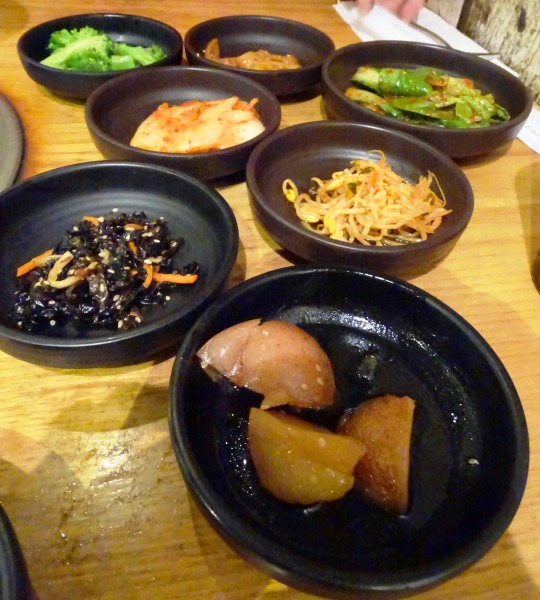

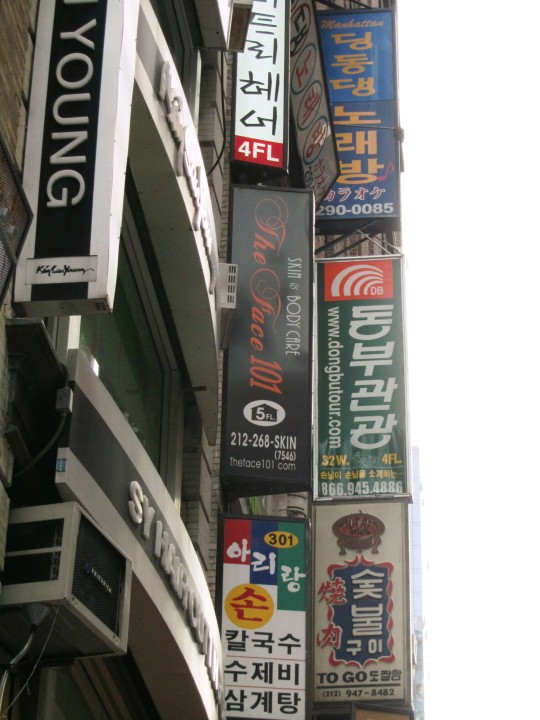



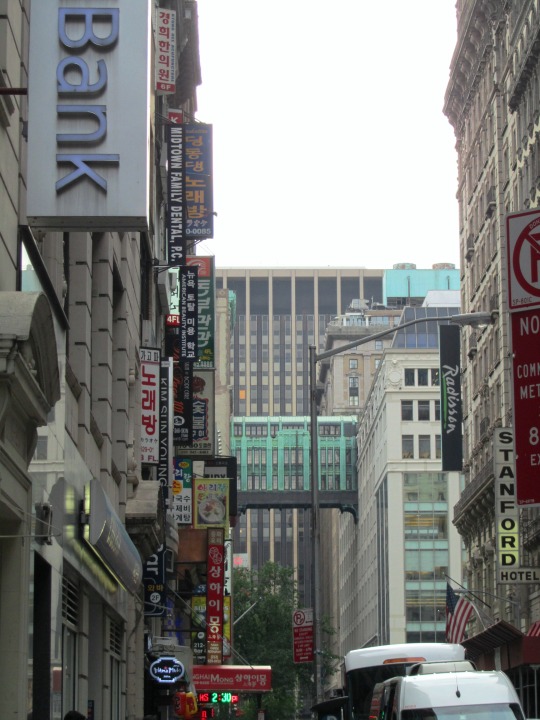
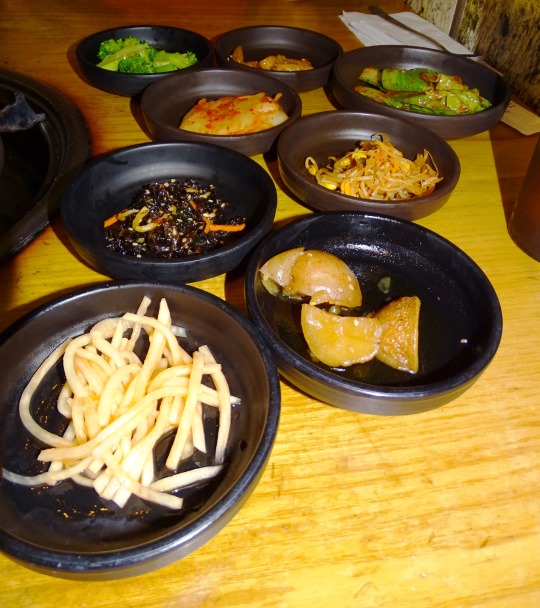
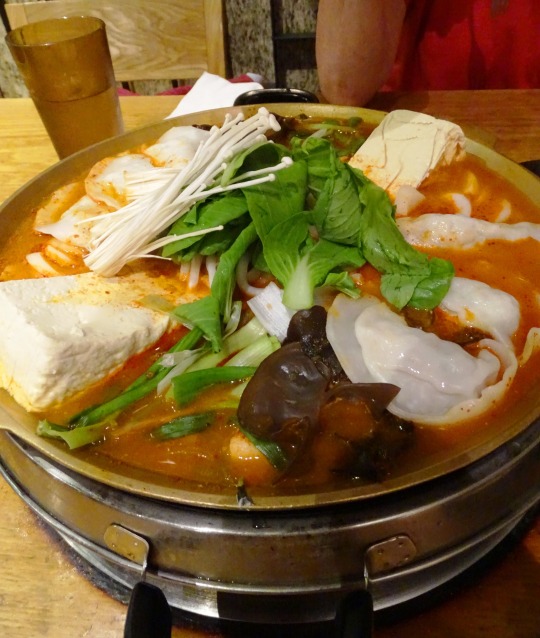

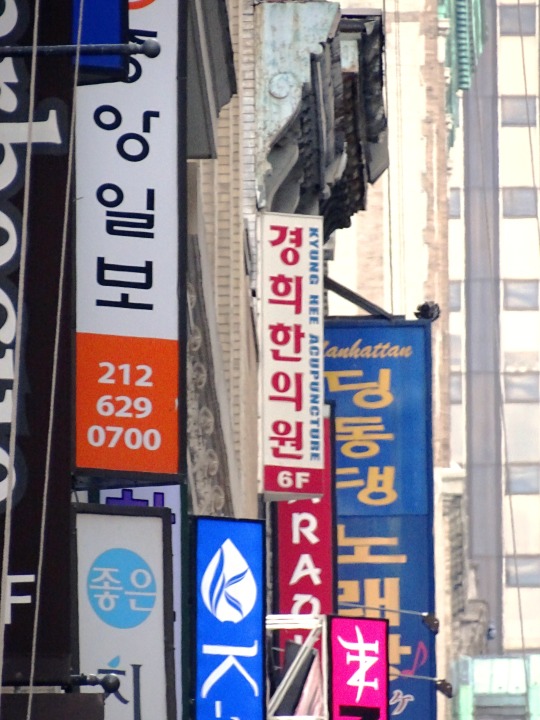
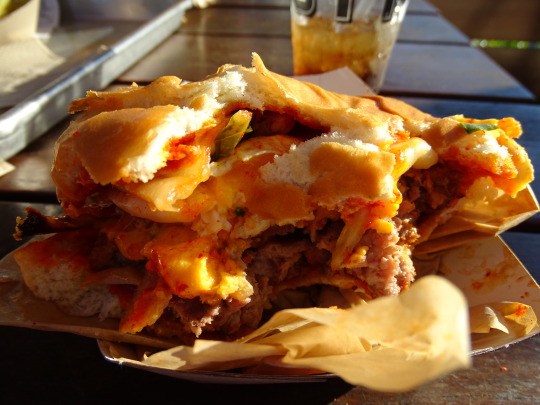
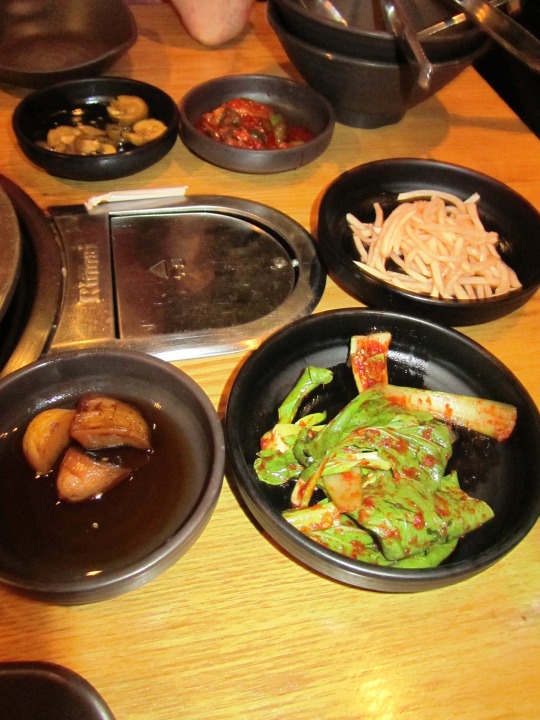

Korean American Day
The unique fusion of Korean and American cultures creates a rich tapestry of art, music, food, and language that's not to be missed!
Celebrating the achievements and contributions of Korean Americans to the United States, Korean American Day is observed annually on January 13th—the date of the first Korean immigrants’ arrival on U.S. soil. Korean American Day is recognized as a time for Korean Americans to reflect on their history, celebrate their culture, and honor the sacrifices of their ancestors who came to the United States seeking a better life.
History of Korean American Day
On January 13, 1903, a group of 102 immigrants, mostly young men, arrived in Honolulu, Hawaii on the RMS Gaelic. They were the first Korean immigrants to arrive in the United States, and sought a better life, hoping to find work in the sugarcane plantations.
The holiday was first celebrated in 2002 and is recognized by the United States government, but is not a federal holiday.
Korean American Day Timeline
January 13, 1903
Arrival of the RMS Gaelic
The first Korean immigrants arrive in the United States, landing in Honolulu, Hawaii.
August 15, 1948
Republic of Korea established
After Japan’s defeat in World War II, the United States and the Soviet Union divide the Korean Peninsula along the 38th parallel. The United States establishes the Republic of Korea in the southern half, while the Soviet Union establishes the Democratic People’s Republic of Korea in the north.
June 25, 1950
Korean War begins
The Korean War breaks out when the North Korean People’s Army invades South Korea. The United States comes to the aid of South Korea and leads a coalition of United Nations forces in the war. The conflict ultimately ends in 1953 with an armistice, but no official peace treaty is signed.
October 3, 1965
Immigration and Nationality Act is passed
This act abolishes the national origins quota system that had been in place since the 1920s, allowing for a more diverse range of immigrants to come to the United States. As a result, the number of Korean immigrants to the United States increases significantly.
2005
Korean American Day established
After its first proclamation by President George W. Bush in 2003, Korean American Day is officially founded as a holiday by the U.S. House and Senate.
How to Celebrate Korean American Day
Korean American Day is celebrated by Korean American communities and organizations, and also those who are interested in Korean American culture. There are several ways to celebrate this day. One can learn about the history and culture of Korean Americans, participate in community events or festivals, visit a Korean American-owned business, or try some Korean American cuisine.
Here are some suggestions for celebrating Korean American Day:
Attend a Korean American Day festival or event
Many Korean American communities and organizations host festivals or events to celebrate Korean American Day. These events often include cultural performances, food, and other activities that allow attendees to learn more about Korean American culture.
Learn about Korean history
A great way to celebrate Korean American Day is to learn about the history of Korean Americans in the United States. This can be done by reading books, watching documentaries, or visiting museums or historical sites.
Try Korean American food
Korean American cuisine is a unique blend of Korean and American flavors, and is a great way to celebrate. Some popular dishes to try include Korean BBQ, kimchi, and bibimbap.
Support Korean American businesses
Korean American businesses contribute greatly to the economy and culture of the United States. Consider supporting a Korean American-owned business by shopping there or spreading the word about their products or services.
Source
#Banchan#Kimchi Mandu Jeongol Hot Pot#Kimchi Burger#Kimchi Fries#Okra Kimchi Fried Rice#Korean American Day#Korea Way#Koreatown#Midtown Manhattan#New York City#summer 2018#2013#sign#original photography#West 32nd Street#tourist attraction#landmark#food#restaurant#vacation#Gott's Roadside#Toronto#Canada#13 January#KoreanAmericanDay#travel#USA
6 notes
·
View notes
Text
Hero: May 29 Prompt from @calaisreno
This latest chapter and the previous ones are here at ao3. (I had hoped to finish with everyone else on the 31st of May, but alas, it looks like it will be May 32nd or 33rd for me . . . ) ...............................................................................................
In Vienna, his search and destroy mission retained its danger; it was as exhausting, and as nerve-wracking as any other part of his journeys to date. It was, however, undoubtedly a much more elegant and luxurious phase. His cover was as an art dealer, an international concierge of sorts, assisting in obtaining the exact object to be placed in exactly the right hands. That this was rarely an above-board legal transaction was, of course, the point. One might say that his current activities fell under the umbrella of the art of money laundering.
Although there had been recent flurries on the part of policing agencies to upend the illicit trafficking of art and antiquities, the Moriarty organization, like many other criminal enterprises, had been delighted to add participation in the circulation of fake and stolen artworks to their already robust departments of fraudulent real estate deals, as vehicles for making illegal monetary gains appear to be legitimate. Auction houses and the like were under no obligation to report large cash transactions to governing authorities -- unlike banks, life insurance companies, casinos, currency exchangers, and precious metal dealers. They could even keep the names of buyers and sellers anonymous. It was like stealing candy from a baby.
His activities had him bouncing from the unsavory world of back-street feloniusness, to the elite world of the over-monied and the over-gullible. Personally, he himself believed that, in a properly-run world, it would be perfectly acceptable if being a billionaire was illegal, but no one had asked him, as such, to draw up plans toward that end. At the very least, he could kill two birds with one stone, by draining the coffers of the obscenely-wealthy as expertly as possible, while also bleeding dry the Order of Moriartyites.
There was a completely legal print gallery next door to the famous Opera House, and he had come to enjoy dropping by on occasion when he wanted to simply enjoy art for recreational reasons, rather than pecuniary ones. The gallery possessed one of the largest collections of original Japanese woodblock prints in Europe, and he had become particularly captivated by their collection of pieces by the nineteenth-century master of ukiyo-e ("pictures of the floating world"), Tsukioka Yoshitoshi. There were many mesmerizing items from two of his series -- 100 Aspects of the Moon and New Forms of 36 Ghosts -- but the images that he especially craved to return to and study, were from his 50 renditions of Handsome and Brave Heroes of the Suikoden, fantastical images of spirits, monsters, and magical creatures, drawn from legendary histories and myths.
On his last day in Vienna, he indulged himself by buying a copy of "Toraomaru Riding a Tiger," an image that encapsulated the feeling that was his constant companion, of living out a life reflecting the aphorism, "He who rides the tiger, dare never dismount." It was a reckless thing to do -- he had no fixed location, no place to store anything important, and whatever he "owned" was only on loan to him as a temporary matter, as it might have to be jettisoned or abandoned at a moment's notice. Nevertheless, he stubbornly refused to submit to practicality in this one instance.
A month later, after many different instances of meditating upon his Yoshitoshi print, the reason the universe had wanted him to own it became clear. While running down new leads on the west coast of the States, he had passed a tattoo shop one day in San Francisco, and impulsively stopped in to see if he could make arrangements soon, in the time before he would have to leave, to have one of the artists interpret the Toraomaru on his left arm. Two days later, he had the art piece vibrantly reproduced, and healing, on his body (and, not so incidentally, allowing the marks from his drug injection days to disappear). His intimate acquisition was a defiant, sentimental, and minutely optimistic act of voicing the unvoiced center of his existence, even if visually, rather than aurally.
And, as someone dear to him from his past might have said: quite apropos for a drama queen.
........................................................
@calaisreno @totallysilvergirl @friday411 @peanitbear @original-welovethebeekeeper
@helloliriels @a-victorian-girl @keirgreeneyes @starrla89 @naefelldaurk
@topsyturvy-turtely @lisbeth-kk @raina-at @jobooksncoffee @meetinginsamarra
@solarmama-plantsareneat @bluebellofbakerstreet @dragonnan @safedistancefrombeingsmart @jolieblack
@msladysmith @ninasnakie @riversong912 @dapetty
.............................................................................
31 notes
·
View notes
Text
Meet the two newest beer openings in Manhattan

Who says beer is dead? Two new venues in Manhattan have opened this month to prove otherwise, and they’re ready to serve you beer.
First up is New York Beer Dispensary, a new beer bar and bottle shop that’s opened on 14th Street between 7th and 8th Avenues. The spot boasts 20 tap lines that include plenty of local and high-profile breweries, like Finback, Evil Twin, Trillium, and Fidens, plus a slew of bottles and cans for drink-in and takeaway. The bar features $2 off drafts at happy hour (weekdays noon to 6pm), weekly beer tastings, and wine and ciders for the beer-averse. New York Beer Dispensary is located at 223 West 14th Street and is open daily from noon until midnight Sunday through Wednesday, and until 1am Thursday through Sunday.
Next is Brooklyn-based TALEA Beer Co.’s third location in Manhattan and fifth overall, this time mere steps from Penn Station and Madison Square Garden at Penn 11, on 32nd Street between 6th and 7th Avenues. If you’ve been to the brewery’s other taprooms, you know what to expect: a bright, colorful, cheerful environment, plenty of IPAs and sours on tap, a range of non-beer and non-alcoholic beverages, and some snack options. The space is a bit more utilitarian than their other locations, but with a location like this, it’s less a place to spend a ton of time and more a place to grab a drink before catching the train or heading into the Garden for a game or concert. TALEA Penn District is located at 160 West 32nd Street and is open daily from 3 to 9pm.
2 notes
·
View notes
Text
Mardi Gras Film Festival announces full program for 2025
New Post has been published on https://qnews.com.au/mardi-gras-film-festival-announces-full-program-for-2025/
Mardi Gras Film Festival announces full program for 2025

Queer Screen is calling on cinema lovers to come together at the 32nd Mardi Gras Film Festival (MGFF) in Sydney from February 13-27 in 2025.
“Come for the love of cinema, the love of queer films, and the love of community!” MGFF festival Director Lisa Rose said on Wednesday.
This year’s festival includes almost 150 of the world’s best LGBTQI+ films, presented across 72 sessions at Event Cinemas George Street and Hurstville, Dendy Cinemas Newtown, and Ritz Cinemas in Randwick.
Special events are also being held at the State Library of NSW and additional screenings at The Rocks Laneway Cinema and Bank Hotel to complete the program.
Highlights from the festival will also be available to stream online, on demand, for viewers across Australia from February 28 until March 10.
Opening and closing nights
The Festival opens on February 13 with YOUNG HEARTS, an adorable, coming of age tale set in rural Belgium, where 14-year-old Elias is navigating his burgeoning feelings for new neighbour, Alexander.
To close the Festival, on February 27, French comedy-drama SOMEWHERE IN LOVE also sees the world open up for its main character, fifty-something single mother Nicole, whose unexpected romance with the beguiling Nora offers respite from her fractured relationship with her teenage son.
Film Premieres at MGFF
Queer Screen is also thrilled to be hosting the world premiere of IN ASHES, a raw debut film from Denmark-based filmmaker Ludvig C. Poulsen, about an awkward twenty-something who is struggling to get over his ex, and gets hooked on hook-ups in the process.
A total of twenty feature films at this year’s festival are Australian premieres, including DRIVE BACK HOME, a darkly funny film in which two estranged brothers (Alan Cumming and Charlie Creed) are trapped on a road trip in 1970s Canada with a taxidermied pug.
THREE KILOMETRES TO THE END OF THE WORLD, which won the Queer Palm at Cannes, is also getting its Australian premiere at the festival. The film follows a young man’s fight for justice after a homophobic attack in his rural Romanian hometown.
Other standout premières include LILIES NOT FOR ME, an English period drama about a romance between a novelist and a doctor who believes he can “cure” their homosexuality, and LAYLA, set in London’s present day queer club scene, where a British-Palestinian drag performer falls for a strait-laced marketing executive.
Chosen family, friends, and strangers
An unorthodox love triangle unfolds under the shadow of the AIDS epidemic in the film TO LIVE, TO DIE, TO LIVE AGAIN – a moving French melodrama about the power of chosen family.
In LOVE IN THE BIG CITY, a decade-spanning and vibrant South Korean comedy-drama, a closeted gay man and an outspoken woman become life-long friends.
Winner of the Berlinale Teddy Jury Award in 2024 (and from the director of MGFF fave And Then We Danced), CROSSING follows a retiree’s search for her runaway niece in vibrant Istanbul.
An intersex runaway (writer River Gallo, in a star-making performance) flees from the New Jersey mob with help from a mysterious cowboy (Australia’s own Murray Bartlett, The White Lotus) in PONYBOI.
Documentaries at MGFF
A heartwarming documentary spanning from the 1940s to today, UNUSUALLY NORMAL follows the lives of a family comprising two lesbian grandmothers, four lesbian mothers and one lesbian granddaughter.
I’M YOUR VENUS is a cathartic ode to Venus Xtravaganza, murdered trans star of 1990 ballroom documentary Paris Is Burning. Overflowing with love for its subject, it focuses on her two families (biological and ballroom) as they honour her legacy.
The documentary program also features profiles of singer/songwriter Ani De Franco (1800-ON-HER-OWN), artist Jürgen Baldiga, who chronicled West Berlin’s 1980s radical queer scene (BALDIGA: UNLOCKED HEART), lesbian feminist Sally Gearhart, an activist in San Francisco in the 1970s and ‘80s (SALLY!), and Black trans singer Jackie Shane, who rose to stardom during the 1960s (ANY OTHER WAY: THE JACKIE SHANE STORY).
For the love of Liza
To coincide with our Australian premiere screening of Bruce David Klein’s new documentary LIZA: A TRULY TERRIFIC ABSOLUTELY TRUE STORY – a dazzling profile of an enduring gay icon and Hollywood survivor – Queer Screen are thrilled to also be presenting CABARET on the big screen. Winner of eight Oscars, the film remains as timely now as ever.
Low budget filmmaking
Wickedly funny satire, Kaye Adelaide’s THE REBRAND follows lesbian influencer power couple Thistle and Blaire as they commission a documentary about themselves to salvage their image after being cancelled, while Lauren Neal’s UNDER THE INFLUENCER, a pulpy, micro-budget thriller, follows a Black lesbian artist who seeks comeuppance upon discovering a cunning white curator has been exploiting her.
Then there’s prolific low-budget Aussie filmmaker Alice Maio Mackay’s take on the festive season in grisly neon slasher, CARNAGE FOR CHRISTMAS.
All three filmmakers are also on the festival’s INTERSECTIONAL GENRE FILMMAKING ON A MICROBUDGET panel.
Sing-a-long with Sister Act!
Following the success of last year’s The Sound of Music sing-a-long, Queer Screen is reprising the event with a screening of Whoopi Goldberg’s SISTER ACT accompanied by entertainment from the Sisters and Brothers of The Order of Perpetual Indulgence, Sydney.
Also screening at the festival is SCARECROW IN A GARDEN OF CUCUMBERS, one of the first ever trans-led feature films. Starring Warhol icon Holly Woodlawn, this ‘70s sketch musical comedy was recently rediscovered after a long time lost. With cameos from Lily Tomlin and Bette Midler, it can finally claim the cult audience it’s long deserved.
Retrospective love @ The Rocks Laneway Cinema
Don’t miss the camp classic THE BIRDCAGE, in which a gay couple (Robin Williams and Nathan Lane) try to convince their son’s ultra-conservative future in-laws they’re not gay. In the equally beloved lesbian classic IMAGINE ME & YOU, Rachel (Piper Perabo) locks eyes with Luce (Lena Headey) while walking down the aisle and tries to convince herself she didn’t just make a big mistake. Count the stars in the night sky above and the iconic guest stars on screen at these free events.
Special events at MGFF
Australia’s richest queer short-film competition, MY QUEER CAREER, will see eight entries battle it out to win over $16,000 worth of cash and in-kind support. Speaking of fierce competition,
Inqueersition, our hugely popular trivia night, is on again at the Bearded Tit.
A panel discussion, It Should’ve Been Queer, will have us bonding over what could have been, while the Queer Screen Pride in Film: Industry Development Series will help local queer filmmakers look ahead with two more panels: Queering the Writer’s Room and Intersectional Genre Filmmaking on a Microbudget, plus a masterclass, From Script(ment) to Screen and a networking event.
Queer Screen’s 32nd Mardi Gras Film Festival is supported by Allianz, our Major Partner. “Allianz is presenting a range of key sessions, and supporting our Community Screenings, allowing us to offer significantly discounted, $12 tickets,” said Queer Screen Co-Chair Angela Ruchin.
Queer Screen is also grateful to receive funding from our Government Partners, Screen NSW and the City of Sydney.
“On behalf of Queer Screen, I extend my heartfelt thanks to all our partners, whose support has a positive impact on filmmakers and audience members alike,” Co-Chair Abs Osseiran said.
“Their contribution enables us to deliver two festivals a year and, through programs such as Pitch Off and the Completion Fund, directly support queer storytellers.”
Tickets and passes for MGFF25 are on sale now. Queer Screen memberships are also available and offer discounted tickets and priority entry. -Visit www.queerscreen.org.au, use the Queer Screen Mardi Gras Film Festival app, or call (02) 9280 1533 to book your tickets.
For the latest LGBTIQA+ Sister Girl and Brother Boy news, entertainment, community stories in Australia, visit qnews.com.au. Check out our latest magazines or find us on Facebook, Twitter, Instagram and YouTube.
0 notes
Text
Discover London’s Best Dining and Entertainment Offers

Explore the top offers and deals across London, from luxurious dining experiences at iconic venues to unique entertainment events. Whether you're looking for a gourmet meal with stunning views, a relaxing massage session, or tickets to the latest theater productions, these curated deals offer great value for an unforgettable experience in the city. Enjoy a two-course set lunch and drink at Oblix West for just £39. Elevate your lunch experience at Oblix West, located on the 32nd floor of The Shard, offering panoramic views of West London. Every Monday to Friday, indulge in two courses of sophisticated cuisine from its innovative rotisserie and grill menu. Whether you choose the rich black truffle pasta, grilled dry-aged sirloin, or the fresh seafood spaghetti, each dish is crafted to perfection. Finish your meal with a classic dessert like the New York cheesecake, all while sipping on your choice of wine, beer, or prosecco. This is the ultimate lunchtime treat, set against one of the most iconic backdrops in London. Highlights - Breathtaking Views: Dine with stunning views overlooking London from the 32nd floor of The Shard. - Two-Course Luxury: Enjoy a starter or dessert paired with your main course. - Exclusive Offer: A special exclusive for a luxurious dining experience. Need to Know - Voucher Details: This voucher is valid for two courses and a selected beverage (beer, house wine, soft drink, or glass of prosecco) at Oblix West. - Availability: Monday to Friday, 12 pm - 2:30 pm. - Booking: Advanced booking is recommended. Call 020 7268 6700 to book, mentioning your voucher and security codes. - Voucher Redemption: Present your voucher upon arrival. Printed vouchers are preferred. - Validity: Voucher valid until September 30, 2024. - Exclusions: Not available on bank holidays. Maximum booking of six people. - Service Charge: A discretionary service charge of 14% will be added to the bill. - Cancellation Policy: Inform the restaurant of any changes or cancellations within 24 hours of your booking. Late cancellations will result in the voucher being deemed redeemed. - Dietary Requirements: Contact Oblix directly to ensure your dietary needs are met before purchasing a voucher. - Location: The Shard, 31 St. Thomas Street, London SE1 9RY. - Terms: Voucher cannot be cancelled, amended, exchanged, refunded, or used with any other offer. The Massage Company Ealing is offering massages for £39.95, saving you up to £35! Take your self-care to the next level with a visit to The Massage Company in Ealing. Whether you need to de-stress, recover from an injury, or simply relax, their highly-trained therapists are ready to provide a personalized experience. Choose between a 50 or 80-minute session with options including Deep Tissue, Sports, Classic, and Maternity massages. Located in the heart of Ealing, this is a perfect opportunity to indulge in some much-needed wellness time. Highlights - Massage Variety: Choose from four different massage options: Deep Tissue, Sports, Classic, or Maternity. - Convenient Location: Just a 3-minute walk from Ealing Broadway underground station. - Affordable Wellness: Prices start from £39.95. Available Services - Deep Tissue Massage: Relieves musculoskeletal pain and tension, customizable pressure. - Sports Massage: Prevents and treats injuries, enhances recovery and alertness. - Classic Massage: Promotes relaxation and stress relief, adjustable pressure. - Maternity Massage: Tailored for pregnant women, with special support for comfort. Need to Know - Voucher Details: Valid for a 50 or 80-minute massage at The Massage Company in Ealing. - Eligibility: Offer restricted to those aged 16 and over, and for first-time customers only. A surcharge applies for returning customers. - Availability: Monday to Thursday, 9 am - 9 pm; Friday, 8 am - 9 pm; Saturday, 8 am - 8 pm; Sunday, 10 am - 6 pm. - Validity: Voucher valid until January 31, 2025. - Booking: Call 0203 161 7000 and forward your booking confirmation to [email protected]. Present your voucher upon arrival. - Group Bookings: One voucher per person, maximum group size is five. Simultaneous treatments available, but each person will be in their own treatment room. - Health Considerations: Notify The Massage Company upon booking if you have any conditions, allergies, or injuries. - Pregnancy: The maternity massage option is suitable for pregnant women. - Cancellation Policy: Notify The Massage Company of any changes or cancellations within 24 hours. Late cancellations will result in the voucher being deemed redeemed. - Location: Unit 8, Ealing Broadway Centre, 1 Oak Road, London W5 5JY. - Terms: Voucher cannot be cancelled, amended, exchanged, refunded, or used with any other offer. Save Big on Flights and Hotels with Lastminute.com - Save up to £300: Take advantage of Lastminute.com’s January sale and enjoy incredible savings on flights and hotel bookings. - Wide Range of Destinations: Whether you’re dreaming of a beach escape or a city adventure, Lastminute.com offers a variety of destinations to choose from. - Flight and Hotel Bundles: Bundle your flight and hotel together to unlock even bigger discounts and get the best value for your money. - Flexible Payment Options: Book now and pay later with Lastminute.com’s flexible payment plans, making it easier to plan and budget for your trip. - Limited Time Offer: Hurry, this sale won’t last forever! Don’t miss out on the chance to save big on your next vacation. Visit Lastminute.com today and start planning your perfect getaway at unbeatable prices! £15 instead of £65: The Lightest Element can be seen at Hampstead Theatre. Set in 1956 Boston, The Lightest Element centers on Cecilia Payne-Gaposchkin, a pioneering astronomer poised to become the first woman to chair Harvard's Department of Astronomy. Her progress is jeopardized by a covert investigation accusing her of communist sympathies and the conservative attitudes of her male peers. A student journalist’s request to profile her offers a chance to control her narrative—if the offer is sincere. Stella Feehily’s drama explores the struggle to defy social and scientific norms. Highlights - Exclusive Preview Offer: From September 5 - 11, preview tickets are available for just £10. - Acclaimed Creative Team: Written by Stella Feehily and directed by Hampstead Theatre's Associate Director, Alice Hamilton. - Time-Limited Offer: Save £40 on tickets, available only until October 12. Need to Know - Ticket Validity: This voucher is valid for a ticket to The Lightest Element at Hampstead Theatre on the selected date/time. - Entry Requirements: Present your booking confirmation upon arrival at the box office. - Re-Entry Policy: Due to the layout of the theatre, re-entry is not permitted if you leave the auditorium during the performance. - Performance Duration: The play runs for approximately 1 hour and 35 minutes without an interval. - Seating: Seats are allocated by the box office. Multiple tickets purchased in the same transaction under the same name will be seated together. - Refunds and Exchanges: Tickets cannot be cancelled, amended, exchanged, refunded, or used in conjunction with any other offer. - Venue: Hampstead Theatre, Eton Avenue, Swiss Cottage, NW3 3EU, London For more exclusive offers on lifestyle visit WhatsOn Enjoy a two-course set lunch and drink at Oblix West for just £39. The Massage Company Ealing is offering massages for £39.95, saving you up to £35! Save Big on Flights and Hotels with Lastminute.com £15 instead of £65: The Lightest Element can be seen at Hampstead Theatre. Read the full article
0 notes
Text






Lorain Avenue Commercial Historic District (Lorain Fulton Square)
3202-5730 Lorain Ave.
Cleveland, OH
Buildings on the northern side of Lorain Avenue (State Route 10) east of the Forty-first Street intersection in Cleveland, Ohio, are part of the Lorain Avenue Commercial Historic District, a historic district that is listed on the National Register of Historic Places. Fulton Road is one of seven streets that were originally designed to radiate from Franklin Circle in accordance with the 1836 subdivision plat created by Ohio City pioneer real estate developers Josiah Barber and Richard Lord. Starting at the Circle, it runs for one-half mile in a southwesterly direction, intersecting several grid streets at sharp angles, before terminating--at least until 1905--at Lorain Avenue (then, Lorain Street). It is unknown whether Barber or Lord envisioned it, but the original terminus of Fulton Road was destined to become one of the most commercially important corners on the west side of Cleveland in the late nineteenth and early twentieth centuries.
At least since 1993, when the Cleveland Landmarks Commission cataloged historic buildings on Lorain Avenue between West 32nd and West 58th Streets during the process that created the Lorain Avenue Commercial Historic District on June 17, 1994, the City has been aware of the extent of the deterioration and loss of historic buildings at or near Lorain-Fulton Square. Before Landmarks Commission intern Don Petit walked up and down Lorain Avenue in that year, snapping photos of the historic buildings, many historic buildings were already lost--burned down, torn down or perhaps blown down in the 1953 Tornado. The photos he took were part of a City effort to save the remaining historic buildings. Many of the buildings that were still standing at or near the intersection of Lorain and Fulton when Petit walked the area in 1993, no longer are. Lorain Fulton Square has become a very different place than it was one hundred or even thirty years ago.
1 note
·
View note
Link
0 notes
Text
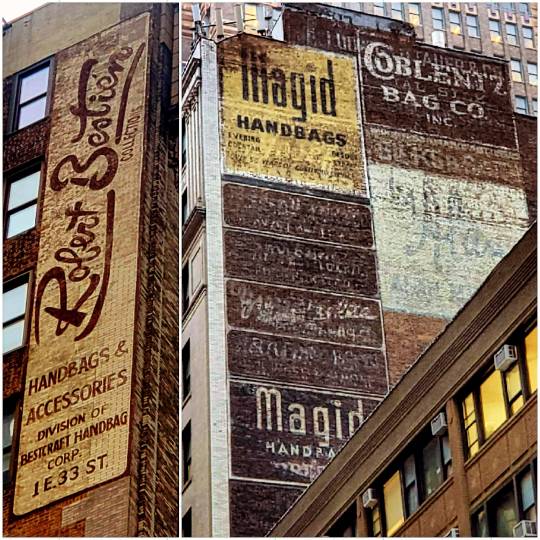
I recently came across these old school painted signs/advertisements on a couple of buildings near 5th Avenue and 33rd Street and Madison Avenue and 32nd Street. They all seem to be advertising handbags and the like. I looked up the companies listed. Here is what I found.
Robert Bestien was located at 1 East 33rd Street from 1978 to 1987. The company specialized in handbags and leather goods since the 1950s.
The Magid Handbags name brand has been around since 1916 and was created by Eastern European immigrants Anna and Isaac Magid. As per the MagicNYC website The, The Rand family led by patriarch Moishe Rand started making handbags in 1956 and is still a family owned and run company in the hands of the Rands.
The Coblentz Bag Company was created by Frenchman Louis B. Coblentz and was established in 1935 at 6 West 33rd Street. The company would move to 30 East 33rd Street in 1938. They were there until the business went out of business in 1980.
For Further Reading:
Robert Bestien, 1 E. 33rd St. (2003) from 14to42.net
Magid, Coblentz, Alan Miller, etc., 30 E. 33rd St. (Crystal Bldg.) near Madison Ave. (2002) from 14to42.net
MagidNYC.com
The Coblentz Bag Company from the Bag Lady Emporium website
#Robert Bestien#Magid Handbags#Coblentz Bag Company#Ghost Advertisments#Painted Signs#Manufacturing History#New York History#NY History#NYC History#History#Historia#Histoire#Geschichte#HistorySisco
0 notes
Text
Grace Street Coffee and Desserts (Koreatown NYC) Review ❤️❤️❤️
My partner and I agree: West 32nd between Broadway and 5th Avenue in Koreatown should be no-car. In the evenings, the sidewalks are always spilling into the street with college students and the post-9-to-5-ers waiting for tables at KBBQ joins like Jongro BBQ (hella pricey, but really good); pushing their way though cereal-encrusted churro and Mama’s taiyakis revelers directly inside Food Gallery…

View On WordPress
0 notes
Text
Grace Street Coffee and Desserts (Koreatown NYC) Review ❤️❤️❤️
My partner and I agree: West 32nd between Broadway and 5th Avenue in Koreatown should be no-car. In the evenings, the sidewalks are always spilling into the street with college students and the post-9-to-5-ers waiting for tables at KBBQ joins like Jongro BBQ (hella pricey, but really good); pushing their way though cereal-encrusted churro and Mama’s taiyakis revelers directly inside Food Gallery…

View On WordPress
0 notes
Link
[ad_1] OAKLAND – A suspect and two officers were injured in a police pursuit Wednesday in Oakland, police said. The chase kicked off just after 5 p.m. when undercover officers witnessed an armed carjacking near 32nd and West streets, Oakland police Officer Rosalia Lopez said. Lopez said officers briefly pursued the suspects, who were caravanning with other vehicles, before handing the chase off to Argus, the police department’s helicopter. As officers headed to the scene, one of the vehicles collided with a marked patrol vehicle, Lopez said. Multiple people were then taken into custody. Lopez said two officers and an individual linked to the carjacking were taken to a hospital. A fourth person, described by Lopez as a victim, was also hospitalized, but it was not immediately clear if they were injured in the carjacking or the crash. None of their injuries was considered life-threatening. Officers recovered a firearm at the scene, Lopez said. Anyone with information related to the case can contact the OPD Robbery Section at 510-238-3482. Check back for updates. [ad_2] Source link
0 notes
Text
























Korean American Day
The unique fusion of Korean and American cultures creates a rich tapestry of art, music, food, and language that's not to be missed!
Celebrating the achievements and contributions of Korean Americans to the United States, Korean American Day is observed annually on January 13th—the date of the first Korean immigrants’ arrival on U.S. soil. Korean American Day is recognized as a time for Korean Americans to reflect on their history, celebrate their culture, and honor the sacrifices of their ancestors who came to the United States seeking a better life.
History of Korean American Day
On January 13, 1903, a group of 102 immigrants, mostly young men, arrived in Honolulu, Hawaii on the RMS Gaelic. They were the first Korean immigrants to arrive in the United States, and sought a better life, hoping to find work in the sugarcane plantations.
The holiday was first celebrated in 2002 and is recognized by the United States government, but is not a federal holiday.
Korean American Day Timeline
January 13, 1903
Arrival of the RMS Gaelic
The first Korean immigrants arrive in the United States, landing in Honolulu, Hawaii.
August 15, 1948
Republic of Korea established
After Japan’s defeat in World War II, the United States and the Soviet Union divide the Korean Peninsula along the 38th parallel. The United States establishes the Republic of Korea in the southern half, while the Soviet Union establishes the Democratic People’s Republic of Korea in the north.
June 25, 1950
Korean War begins
The Korean War breaks out when the North Korean People’s Army invades South Korea. The United States comes to the aid of South Korea and leads a coalition of United Nations forces in the war. The conflict ultimately ends in 1953 with an armistice, but no official peace treaty is signed.
October 3, 1965
Immigration and Nationality Act is passed
This act abolishes the national origins quota system that had been in place since the 1920s, allowing for a more diverse range of immigrants to come to the United States. As a result, the number of Korean immigrants to the United States increases significantly.
2005
Korean American Day established
After its first proclamation by President George W. Bush in 2003, Korean American Day is officially founded as a holiday by the U.S. House and Senate.
How to Celebrate Korean American Day
Korean American Day is celebrated by Korean American communities and organizations, and also those who are interested in Korean American culture. There are several ways to celebrate this day. One can learn about the history and culture of Korean Americans, participate in community events or festivals, visit a Korean American-owned business, or try some Korean American cuisine.
Here are some suggestions for celebrating Korean American Day:
Attend a Korean American Day festival or event
Many Korean American communities and organizations host festivals or events to celebrate Korean American Day. These events often include cultural performances, food, and other activities that allow attendees to learn more about Korean American culture.
Learn about Korean history
A great way to celebrate Korean American Day is to learn about the history of Korean Americans in the United States. This can be done by reading books, watching documentaries, or visiting museums or historical sites.
Try Korean American food
Korean American cuisine is a unique blend of Korean and American flavors, and is a great way to celebrate. Some popular dishes to try include Korean BBQ, kimchi, and bibimbap.
Support Korean American businesses
Korean American businesses contribute greatly to the economy and culture of the United States. Consider supporting a Korean American-owned business by shopping there or spreading the word about their products or services.
Source
#BBQ Korean Bowl with sesame#Banchan#Kimchi Mandu Jeongol Hot Pot#Kimchi Burger#Kimchi Fries#Okra Kimchi Fried Rice#Korean American Day#Korea Way#Koreatown#Midtown Manhattan#New York City#summer 2018#2013#sign#original photography#West 32nd Street#tourist attraction#landmark#food#restaurant#vacation#Gott's Roadside#Toronto#Canada#13 January#KoreanAmericanDay#travel#USA#Calgary
0 notes
Text
Und abends?
… sind die Möglichkeiten natürlich auch grenzenlos. Zumindest vom Angebot in der Stadt. In unserem Alter sind wir nach einem Tag in New York ziemlich geschafft und können uns nicht an jedem Abend aufraffen.
Am Tag unserer Ankunft gehen wir abends noch in eine Bar, die Clinton Hall. Dort wird gespielt, ein DJ macht Musik, viele junge Leute treffen sich auf einen Drink. Die Barkultur in New York hat mich schon immer begeistert. Ganz unterschiedliche Leute mit unterschiedlichen Hintergründen und Nationalitäten sind abends zusammen und haben eine gute Zeit. Das gibt es bei uns meines Wissens nur vereinzelt.
Am Geburtstag gehen wir abends gut essen. In Manhattan gibt es 72 Sternerestaurants, davon 5 Restaurants mit 3 Sternen. Wir gehen ins Dirt Candy, ein vegetarisches Restaurant in der Lower East Side mit einem Stern. Es gibt ein Menü mit 5 Gängen. Karotten Mille Feuille, Pilzmousse, Erbsenravioli, eingelegten Brokkoli und eine halbgefrorene Erbsenburrata zum Nachtisch. Alles sehr lecker. Ich nehme die Weinbegleitung dazu. Die Weine stammen vor allem von Winzerinnen, die ökologische Weine anbauen. Uns hat im Vorfeld auch gut gefallen, dass es sich um ein „no tip“-Restaurant handelt, d.h. es gibt keine Trinkgelder weil die Politik im Dirt Candy ist, die Mitarbeiter gut zu bezahlen. Ansonsten sind in den USA inzwischen Trinkgelder in Höhe von 20% üblich.
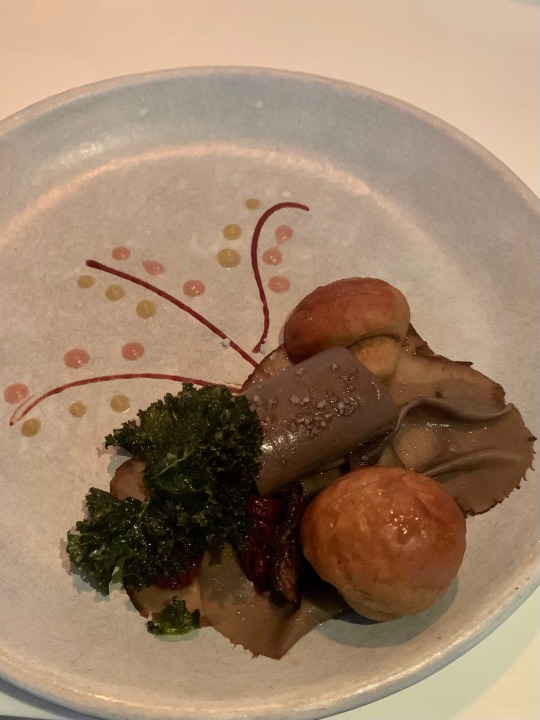
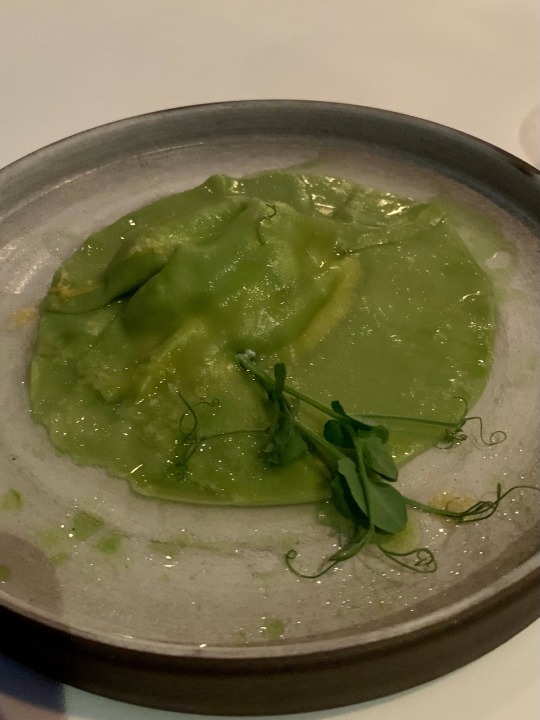
Eigentlich wollen wir nach dem Essen noch in eine Rooftopbar und den Blick in die Nacht von Manhattan genießen. In der ersten Bar, die wir ansteuern, der Strand Bar, sind alle Fensterscheiben geschlossen. Das gefällt uns nicht. Wir ziehen weiter und probieren es im Magic Hours im Moxy Hotel. Die Schlange vor dem Eingang deuten wir als eher gutes Zeichen, aber als wir oben ankommen sind wir doch eher irritiert. Die typischen Gäste sind weiblich, operiert (ohne hier in Details gehen zu wollen) und damit beschäftigt, für Selfies zu posen. Wir ergreifen schnell die Flucht. Das ist nicht unsere Welt. Ohnehin ist es mit den Rooftop Bars in diesem Jahr etwas schwierig. Am Ende gehen wir in eine einzige Rooftop Bar, LeBain & The Rooftop @ The Standard. 444 West 13th Street. Zwischen Chelsea Market und Whitney Museum mit einem schönen Blick auf den Hudson River und Lower Manhattan.
Wir gehen noch ein weiteres Mal gut essen, ins Buddakan am Chelsea Market. Die asiatische Fusionküche ist ausgezeichnet, das Ambiente ebenfalls beeindruckend. Die Empfehlung von Frank war ein guter Tipp. Neben uns sitzt ein Paar mit Essgewohnheiten, die wir sonst eher aus dem Zoo kennen. Dabei guckt jeder auf sein Handy, gerne auch mal ein Video mit Ton, aber das stört uns nicht weiter.

An den anderen Tagen nehmen wir unser Abendessen meistens bei ShakeShack, unserem Lieblingsburgerladen, ein. Die vegetarische Variante wird allerdings wohl nicht oft nachgefragt und ist oft nicht verfügbar. In direkter Nähe des Hotels gibt es einen ShakeShack, bei dem wir draußen sitzen können. Danach geht es dann oft noch in den Bryant Park, wo wir die Aussicht genießen, ein bisschen Musik hören und den Leuten zusehen. Und da ich gerade über das Essen schreibe ergänze ich hier mal noch ein paar unserer Lieblingsläden. Morgens gibt es auch im Hotel Frühstück, was für uns eine absolute Ausnahme ist. Wir frühstücken eigentlich nie im Hotel. Zu einem späteren Zeitpunkt am Tag essen wir gerne einen Bagel, normalerweise ziemlich klassisch mit Cream Cheese, und zwar am liebsten bei Ess-A-Bagel. In der 32nd Street ist auch ein Ess-A-Bagel in unserer Nähe. Auch wenn die Schlangen meistens lang sind, es lohnt sich. Dann gibt es an verschiedenen Stellen der Stadt die Magnolia Bakery, auch ein toller Laden, vor allem für Cup Cakes und einen himmlisch guten Banana Pudding.


Ansonsten snacken wir uns so durch den Tag. An vielen Stellen stehen kleine Wagen mit Essensmöglichkeiten. Einer unserer Favoriten steht an der 45th Street/Ecke 6th Avenue: Kwik Meal.
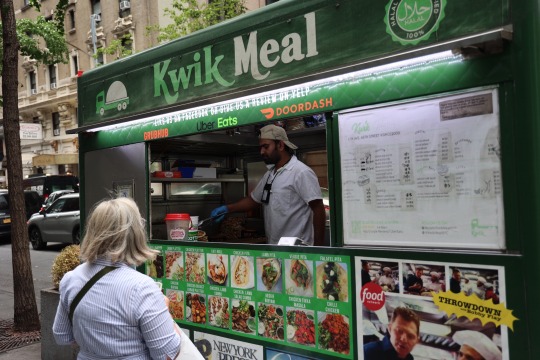
Ein Highlight der abendlichen Unterhaltung ist das Musical Hamilton. Ich hatte von Hamilton gehört, als das Ensemble im Weißen Haus bei den Obamas war und als Armanda Gorman, die bei der Vereidigung von Joe Biden ein Gedicht („The Hill We Climb“) vorgetragen hat, danach darüber sprach, wie sehr Hamilton sie beeinflusst habe. Damals wollte ich unbedingt mal in das Musical gehen und wir hatten auch überlegt. Aber die Ticketpreise sind schon ziemlich abschreckend. Letztlich gab es dann aber doch noch einen kleinen Anstoß (Danke Ann-Katrin), den es manchmal braucht und wir hatten uns noch Karten besorgt. Und es hat sich definitiv gelohnt. Die Geschichte, die Musik, das Ensemble, King George, die Atmosphäre, das Publikum, das bei einzelnen Szenen laut jubelt, … Ein toller Abend.
Danach gehen wir noch in eine Bar, diesmal zu Madame George. Wir sind zunächst etwas irritiert. Eine abgedunkelte Tür ohne Beschriftung. Der Türsteher nebenan sagt uns, dass wir da richtig wären. Wir werden durch verwinkelte Gänge nach unten in einen Keller geführt, Christine will fliehen, aber wir gelangen irgendwann tatsächlich in eine Bar. Wir trinken das erste Mal in New York einen Cocktail, was eigentlich nicht so unser Ding ist. Aber der Gin Gin Mule ist schon sehr lecker.
0 notes
Text
Seven Projects to Reclaim NYC Space From Cars
New York’s first public realm officer is working to shepherd plans in each of the city’s five boroughs that will make it greener and more hospitable to walkers and bikers.
— CityLab | Design | Bloomberg | By Tope Alake | July 11, 2023

A rendering of the plan for Greeley Square in Manhattan. Source: “New” New York Panel
New York City is moving forward with plans to expand many of its pandemic-era efforts to make streets more accessible to pedestrians and bikers.
The changes are being shepherded through with the help of the city’s first public realm officer, Ya-Ting Liu, who has identified priority projects in each of the five boroughs. These projects, which tap some of the $375 million in funding earmarked to make the city “cleaner and greener,” include more pedestrian plazas on congested streets, wider sidewalks and expanded public space, such as an area below the Manhattan side of the iconic Brooklyn Bridge.
Liu is one of just a handful of public realm officers in major US cities tasked with repurposing public space, improving access to transit and making alternative transportation options like biking more accessible. The creation of the role in New York City was championed by community groups that found city agencies too difficult and time-consuming to navigate.

A rendering of the plan for the famed shopping corridor on Fifth Avenue. Source: "New" New York Panel
“To have a new sort of czar of public space is something that we felt has been needed for a long time because it’s really complicated to get these kinds of public realm works done,” said Samara Karasyk, president of Hudson Square Business Improvement District. It took her group a decade to rebuild an industrial Hudson Street in lower Manhattan into a pedestrian-friendly boulevard. She’s hoping Liu will make the next phase of her project – and others throughout the city – easier and faster.
Liu is also charged with helping to bring equity to projects across neighborhoods and boroughs. “The pandemic has really put into sharp focus how important and critical it is to have vibrant and inclusive public spaces,” she said.
Here’s a look at some of the initial projects her office is helping to move from planning to completion.

The view north from West 25th Street and Broadway after public space and street safety improvements.Source: New York City Department of Transportation.
Manhattan, Broadway Vision and The Arches
The first phase of Mayor Eric Adams’ “Broadway Vision Plan” was completed in June, aimed at creating a larger car-free area in midtown Manhattan. It adds two new plazas and a two-way bike lane along Broadway from West 25th Street to West 32nd Street. The project also extends curbs and widens crosswalks to make it easier for cars and trucks to do pickups and drop-offs without blocking traffic. Once completed, the project will stretch about 2.8 miles, from Union Square to Columbus Circle.
In the meantime, a one-acre park called “The Arches” opened in May at the entrance to the Brooklyn Bridge with skating, basketball, pickleball and seating. It’s named after 53 of the structure’s historic arches and is in a busy section of Chinatown. Public access to the area has been closed because of renovations that started in 2010. The nonprofit organization Gotham Park advocated for redevelopment, including a planned reopening of the Brooklyn Banks skate park, to bring parity with public space that is available under the more affluent and less diverse Brooklyn side of the bridge.

Public space under the Brooklyn Bridge. Source: Ed Reed/Mayoral Photography Office
Another Manhattan-based project is aimed at revitalizing Fifth Avenue, from Bryant Park at 42nd Street to Central Park at 59th Street, to add tree plantings, wider sidewalks and additional lighting to the famed shopping corridor. The project is scheduled to be completed within two years.
Brooklyn, Underhill Plaza and Broadway Junction
A new pedestrian plaza on Underhill Avenue in the Prospect Heights neighborhood of Brooklyn is the first step in transforming the corridor that leads to Prospect Park into a bike boulevard. It’s part of a broader plan to expand the open streets program that has partially closed Underhill and Vanderbilt Avenues to car traffic since the pandemic and created space for activities like outdoor yoga classes. The upgrades have helped businesses and local artists by creating inviting, less chaotic space for people to explore their neighborhood — a contrast to the bustle on nearby Atlantic Avenue, said Jackson Chabot, a director at Open Plans.

Mayor Adams and the MTA in May announced investments in public space, street safety and accessibility upgrades around the Broadway Junction subway station in Brooklyn’s East New York neighborhood. Source: Caroline Willis/Mayoral Photography Office
New York City also recently announced a $500 million investment in the Broadway Junction transit hub to make the station accessible and stimulate economic growth in East New York. Five subway and six bus lines, along with the Long Island Railroad, intersect at the station.
Plans include seven new elevators and escalators, two nearby pedestrian plazas, plantings and vending areas. The station has long been ignored and an upgrade has been overdue, Chabot said. Nearby housing, office and retail space are also expected to go up around the station. The city expects to break ground in 2027 and finish the project in 2030.
Queens, Jamaica Avenue
A stretch of Jamaica Avenue in Queens from 160th Street to Union Hall Street now has granite blocks, tables, chairs and planters aimed at encouraging people to sit, eat, read and meet friends. The stretch of the avenue from Sutphin Boulevard to Merrick Boulevard is getting wider sidewalks, extended curbs and elevated crosswalks. On Queens Boulevard, the city added barriers to extend the protected bike lane.

The new Street Seat on Jamaica Avenue, between 160th Street and Union Hall Street. Source: New York City Department of Transportation
The Bronx, Willis Avenue
Upgrades for Willis Avenue between East 147th Street and Bergen Avenue in the Bronx will include a two-way bike lane separated from traffic and other streetscaping. “The Bronx has incredibly high rates of traffic violence, and outside of its few major parks it is also devoid of neighborhood green space,” Chabot said. “This is a perfect example of equitable investment in public space that will benefit people whether they are commuting, shopping, or just looking to hang out.”
Staten Island, Minthorne Street
In Staten Island, there will be permanent improvements to the Minthorne Street Open Street, turning it into a space shared by cars and pedestrians. The boulevard will connect to the Bay Street public realm improvements at Tompkinsville Park and a new plaza at Central Avenue.
Looking For Inspiration
In addition to the plans already in place, Liu said her team will tap ideas already in place in urban centers like Mexico City, Seattle and Cambridge, Massachusetts. “The importance of creating beautiful, vibrant, inclusive spaces is really important to the quality of life and our city’s economic recovery across all five boroughs.”
It’s a welcome change for advocates who worked to get Liu’s position created. “Most New Yorkers don’t have very large places to live in, so the parks, plazas and the sidewalks are our living rooms,” Karasyk said.
#New York City#Manhattan#Shepherd Plans#Hospitable For Walkers & Bikers#Brooklyn#Queens#Bronx#Staten Island#Mexico City Seattle and Cambridge Massachusetts#Tompkinsville Park#Sutphin & Merrick Boulevards#East New York#Brooklyn Bridge
0 notes
Text
Monday, July 10, 2023
Rising Temperatures Threaten More Than Misery for Oldest Americans (NYT) When the torrential rain stopped on Friday afternoon, Laura Lowry could see the steam rising off the wet pavement. She was on her front porch in the Fifth Ward neighborhood of Houston, desperate for relief from the relentless humidity and 91-degree heat. The air-conditioner in her house worked, but she and her husband, reliant on disability checks, couldn’t afford to run it. The lack of cool air wasn’t simply a matter of discomfort for Ms. Lowry, 73. It was dangerous. Just a few weeks ago, there had been a terrifying moment when she was so taxed by the heat after waiting outside a food pantry that she had slumped into her porch chair as soon as she got home. “I couldn’t make it inside,” she said. “I felt like I was passing out.” Another wave of dangerous heat sweeping across the South and into the West this week has posed particular perils for older people, who are among the most vulnerable to such extreme conditions. The aging process makes older bodies generally less capable of withstanding extreme heat, doctors say. “They’re at extremely high risk of heat stroke and death,” James H. Diaz, a professor of environmental and occupational health sciences at Louisiana State University’s School of Public Health, said of older people. “When we look at what happens with these heat waves, most of the deaths occur in the homebound elderly.”
Flooding in New York State (AP) Heavy rain spawned extreme flooding in New York’s Hudson Valley that killed at least one person, swamped roadways and forced road closures on Sunday night, as much of the rest of the Northeast U.S. began bracing for potentially punishing rains. As the storm moved east, the National Weather Service extended flash flood warnings into Connecticut, including the cities of Stamford and Greenwich, before creeping into Massachusetts. Forecasters said some areas could get as much as 5 inches (12 centimeters) of rain. In New York’s Hudson Valley, rescue teams were attempting to retrieve the body of a woman in her 30s who drowned after being swept away while trying to evacuate her home. Two other people escaped.
NATO’s unity will be tested at summit in Vilnius (AP) As the Russian invasion of Ukraine continues with no end in sight, NATO’s much-celebrated unity faces fresh strains when leaders gather for their annual summit this week in Vilnius, Lithuania. The world’s biggest security alliance is struggling to reach an agreement on admitting Sweden as its 32nd member. Military spending by member nations still lags behind longstanding goals. And an inability to compromise over who should serve as NATO’s next leader forced an extension of the current secretary general’s term for an extra year. Perhaps most thorny are questions over how Ukraine should be eased into the alliance. Some maintain admitting Ukraine to NATO would be the fulfillment of a promise made years ago and a necessary step to deter Russian aggression in Eastern Europe. Others are fearful it would be seen as a provocation that could spiral into an even wider conflict. The challenges come at a moment when President Joe Biden and his counterparts are heavily invested in demonstrating harmony among members.
This Paris Suburb Burned Before. Has Anything Changed? (NYT) In the fall of 2005, Faisal Daaloul was a young adult protesting in the streets of Clichy-sous-Bois, an impoverished Paris suburb seething over the death of two teenagers as they were pursued by police officers. After the spasms of public anger, he hoped that France would finally turn its attention to its long-neglected suburbs and their minority communities. Fast forward nearly 20 years. Mr. Daaloul is now a father. He struggled to keep his 18-year-old son from joining recent violent protests set off by the police killing of a teenager that many blamed on racist attitudes. Little has changed in two decades,” Mr. Daaloul said. In reality, much has changed. After the 2005 riots, the French government invested billions of euros to revamp its immigrant suburbs, or banlieues, to try to rid them of run-down social-housing blocks. But the similarity of the recent riots has raised questions about whether the efforts to improve conditions in the banlieues have failed. Residents of the neighborhoods and experts say the redevelopment programs have, indeed, fallen well short of their goals, even as they acknowledge the many changes the efforts have brought. The reasons for the failure, they say: Change has come too slow, and, perhaps more important, the government programs have done little to address deeper, debilitating issues of poverty and discrimination. “We took action on the buildings, but not on the people who lived in them,” said François Dubet, a sociologist at the University of Bordeaux, in southwestern France. “Unemployment remains very high, racism is still a commonplace experience, discrimination is a daily reality, and the youth and the police continue to clash.”
Ukraine pushes to reclaim Bakhmut, fighting on fallen city’s flanks (Washington Post) The capture of Bakhmut in May, after the war’s longest and bloodiest battle, was Moscow’s only significant territorial gain so far in 2023. Wagner mercenaries, who led the months-long siege of the city, claimed victory in May and quickly withdrew, turning over responsibility for holding it to regular Russian units. Now, with Ukraine mounting its long-awaited counteroffensive, the battle has shifted to the destroyed city’s flanks. “We are trying to pin as many Muscovites as possible around Bakhmut,” said Mykola Bielieskov, a research fellow with Ukraine’s National Institute for Strategic Studies. To the north, the Ukrainians have pushed toward Yagidne and Berhivka. To south, they’ve been moving on Klishchiivka and Kurdyumivka amid a landscape dotted with abandoned coal mines and giant slag piles grown over with trees. Ukrainian troops have also encountered Wagner Group’s successors for the first time—a force known as Storm Z that is under the control of Russia’s Defense Ministry and includes a mix of reservists, conscripts and convicted criminals.
Japan to release water from Fukushima nuclear plant (Washington Post) Japan plans to release more than 1 million metric tons of treated radioactive water from the Fukushima Daiichi nuclear plant into the Pacific Ocean, a process set to begin this summer and continue for three decades or more. For years, the contaminated water—equivalent to more than 500 Olympic-size swimming pools—has been stored in large metal tanks near the plant, the site of one of the worst nuclear disasters in history. But Japan is running out of space to build more tanks to accommodate the contaminated groundwater and rainwater that continues to enter the site. The pending release has become highly politicized by neighboring countries, including South Korea and China. Fukushima’s fishing and agricultural industries are also worried about potential reputational harm on their products, which still carry the stigma of radioactive exposure. The Japanese public is split on the plan, and many remain distrustful of the government and Tokyo Electric Power Co. (TEPCO), which has been criticized for playing down bad news about the severity of the disaster in the early days.
Keeping up pressure, China sends warships and fighter jets near Taiwan during Yellen’s Beijing visit (AP) China’s People’s Liberation Army sent 13 aircraft and 6 vessels into airspace and waters around Taiwan over the past 24 hours as of early Saturday, overlapping with United States Treasury Secretary Janet Yellen’s visit to Beijing aimed at mending strained relations. Taiwan’s Defense Ministry said it is monitoring the situation from the air and sea, and land-based missile systems were prepared to respond. It said four Chinese aircraft—two SU-30 fighters, one BZK-005 reconnaissance plane and one Y-8 anti-submarine warfare plane—crossed the median line in the Taiwan Strait that serves as a de-facto border between the sides, and had entered Taiwan’s southwestern air defense identification zone. China claims Taiwan as its own territory to be annexed by force if necessary and sends air and naval missions on virtually a daily basis in an attempt to wear down the island’s defense capabilities and intimidate its 23 million people, who thus far seem largely unfazed by such moves.
Israeli protests reignite as Netanyahu pushes new justice bill (Reuters) Israel’s business hub Tel Aviv saw the biggest anti-government protest in weeks on Saturday against a renewed push by Prime Minister Benjamin Netanyahu’s hard-right coalition to overhaul the justice system. Tens of thousands demonstrated across the country, with the rally in Tel Aviv drawing crowds far larger than recent protests, news channels N12 News and Channel 13 reported. Nationwide demonstrations began in January when the government announced a plan to overhaul the judiciary with a legislation package that would roll back some Supreme Court powers and give the coalition decisive sway in picking judges.The protests subsided a little from late March when Netanyahu, under pressure at home and abroad, suspended the plan for compromise talks with opposition parties meant to reach broad agreement over justice reforms. But, deeming the talks pointless last month, Netanyahu re-launched his government’s quest to rein in what it sees as an overreaching, left-leaning and elitist Supreme Court.
Airstrike in Sudanese city kills at least 22, officials say, amid fighting between rival generals (AP) An airstrike in a Sudanese city on Saturday killed at least 22 people, health authorities said, in one of the deadliest air attacks yet in the three months of fighting between the country’s rival generals. The assault took place in the Dar es Salaam neighborhood in Omdurman, the neighboring city of the capital, Khartoum, according to a brief statement by the health ministry. The attack wounded an unspecified number of people, it said. The ministry posted video footage that showed dead bodies on the ground with sheets covering them and people trying to pull the dead from the rubble. Others attempted to help the wounded. People could be heard crying.
It may not be safe to mail checks anymore (USA Today) Neither snow nor rain nor heat nor gloom of night, the adage goes, will stop postal workers from delivering the mail. But what about robbery? The U.S. Postal Service is taking steps to tamp down an increase in robberies of mail carriers and in mail theft, both of which have contributed to a rise in check fraud. While the U.S. Postal Service has not officially warned customers about putting personal checks in the mail, some experts are suggesting folks use caution when sending checks. "Where it's possible to pay things through online means, that's definitely something to consider, it may be more secure to pay through online," Chuck Bell, programs director, advocacy, for Consumer Reports, told USA TODAY. "I mean there's problems with that as well, but you would avoid the risk of having the check intercepted and cashed by someone else."
0 notes
Photo

C. W. Sparks Contractor 1925 (photo taken by me in May of this year).
Sparks was a director of The California-Arizona Construction Co. of Los Angeles, CA, which incorporated with a capital stock of $160,000. “The company is being formed to engage in a general engineering-contracting business in Southern California and Arizona, expecting to operate in all classes of street and highway paving, sewer construction, etc. When organized the new company will take over the business and probably the plants and equipment of the Barber Asphalt Paving Co. in this territory, the latter to retire from construction work on the Pacific Coast.” Apparently, Sparks and some of his co-directors had “for some time been connected with the Barber company.” (Southwest Contractor, May 29, 1914, pgs. 8-9).
Sad to say C. W. Sparks and Maida Dorothy Sparks were foreclosed upon by Hulda Franciska Schmidt in November of 1918. The L.A. County Sheriff was selling “Lot seventy-one of Tract number 2140 (commonly known as The McCarthy Company’s West Ninth Street Heights) as per map recorded in book 21, page 185 of maps in the office of the county recorder of [Los Angeles] county]. Together with the tenements, hereditaments and appurtenances thereunto belonging or in anywise appertaining.”

(Southwest Builder and Contractor, Volume 52, F.W. Dodge Company, 1918).
In 1921, Sparks received “a truck load of 480 feet of 18-inch and 60 feet of 24-inch Armco ingot iron pipe” for Los Angeles County road near Puenti, twenty miles from Los Angeles (“Shipping Culverts by Truck.” The Highway Magazine, April, 1921, Vol. XII, No. 3, Armco Culvert & Flume Manufacturers’ Association, 1921).
In 1922, Sparks worked out of the San Fernando Building (#433), which is at 400-410 S. Main Street in the historic core of downtown Los Angeles. From there, he “submitted a low bid for the installation of an ornamental lighting system on Sixth Street between Pacific Avenue and Gaffey Street, San Pedro district, and will receive the contract for the work.” He also bid but lost “the contract for the installation of an ornamental street-lighting system on certain streets at La Jolla, near San Diego, Cal.” (Electrical Records and Buyer’s Reference, Volume 33, Buyers’ Reference Company, 1922).
In 1926, Sparks was located in one listing at 142 N. Commonwealth Ave. (today in Rampart Village neighborhood of Los Angeles). He submitted the low bid for improving Prospect Ave. between Talmadge St. and Vermont Ave., including grading, concrete paving, “remodfi. with rock and oil, ...unplas. light curb, ...course sec. walk,” gutter, storm drain, and sewers. Higher bidders included some I’ve written about before, including Oswald, McCray, Curtis, Griffith, Shafer, and Spencer & Holt (Building and Engineering News, Volume 26, Issue 1, 1926). In another listing the same year, Sparks was located at 1033 W. 32nd St. (right near USC) and submitted the low bid to the Board of Public Works for improving Argosy Way between Tuxedo Terrace and Canyon Dr., involving grading, concrete pavement, curb, special curb, unplastered curb, walk, stairway, sanitary sewer, and “hse. conn.”
0 notes